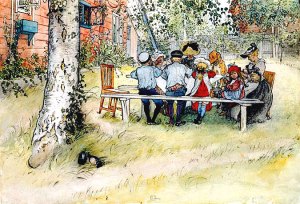A family sits at a table under a big birch tree, in a garden behind a house. A well-worn path runs by the table. The benches are filled – even the dog is there, feet on one of the benches, head cocked, waiting. We can see smiling faces under the hats that shelter girls and women from the sun. An empty chair – the artist’s chair? – sits crookedly on the longish grass. Except for the little girl looking inquisitively toward us, everyone is busy eating. Something – a toy? – lies discarded on the grass.
It takes a while to notice how the artist draws us into the picture. The path crossing in front of the table helps to define the space the family sit in. The birch tree and the slant of the house wall frame and draw our eyes to the table and the group sitting at it. The lines of the back fence, the plants along the wall and the curve of the branches all lead our eyes toward the group.
Yet the scene does not feel composed. Instead, it feels light and friendly and busy. There is no sense that the people in the painting have been carefully posed; they look relaxed and focused on what they are doing, caught at a moment in their day.
They were probably used to being painted. The artist is Carl Larsson; the family gathered under the birch tree is his own. Unlike the family of his own childhood, you can see that times are good and the family happy.
Carl Larsson was born in Stockholm, into an extremely poor family. It was a teacher at the school for the poor who persuaded him, at age 13, to apply for enrollment in the preparatory department of the Royal Art Academy, into which he was accepted. Awkward and shy in the beginning, he settled in as he moved up through the classess.
In spite of his talent, finding success as an artist did not happen quickly. He worked hard to earn his way – as a caricaturist, a graphic artist, an illustrator of books and magazines and newspapers. In 1877 he moved to Paris, but there all his hard work brought him little success. Then he moved to Grez, met his future wife, moved away from painting in oils to painting in watercolors, and his life began to change.
He and his wife, Karin, also an artist, had eight children, and his family became his favorite models and subjects. Of all his work, it was his watercolor paintings of his family and life that became most widely known and very popular, and you can see why. When he created books in which the paintings appeared as full colour reproductions they sold well, allowing the family to live comfortably. It was a life very different from the one he had known as a child.
Why were these books and paintings so popular? The subjects were familiar, the paintings light and lovely. The artist was painting those he loved. Was it the subject matter or love they were painted with that really reached out to the people who saw them?


